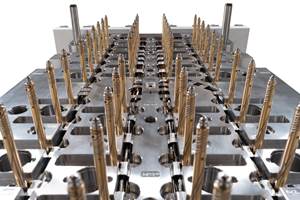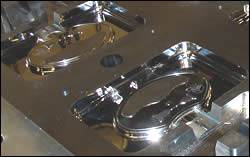Improved Profitability through Process Improvement
Hard milling, automation and magnetic workholding are a winning combination.
As the mold industry adjusts to a global economy, American mold builders need to find ways to compete with countries that have significantly lower labor cost. Some of these changes however are actually giving American mold builders an added edge. High-speed machining and hard milling as a combined process can be up to eight times faster than conventional sinker EDM. Automation reduces redundancies in labor cost and a magnet reduces setup by as much as 50 percent. The combination of the three is a recipe for significant cost reduction. These benefits alone are enough to implement hard milling automation on a magnet. But these three processes offer other benefits that make the added edge.
1. Hard Milling
Hard milling became a commercially viable operation in the 1990s and continues to be a more justifiable option through process refinement to this day. This has resulted in improved part finish, tighter tolerances, and significantly improved repeatability at speeds that reduce operational costs. By its very nature, the hard milling process eliminates the redundant time spent machining an electrode only to then burn it into the steel. The reduction of graphite dust within a shop also is a nice perk.
For a successful hard milling operation, contributing writer and editor of the book Hard Milling and High Speed Machining, Dale Mickelson explains that there are several key elements, "The machine must be rigid and accurate as well as be able to read codes smoothly. Look for holders that will guarantee .0002 or less on the tool and the cutters are a micro carbide. Software also is a special part of the process. Testing shows a difference of 9 to 1 tool life based on software techniques alone."
Hard milling involves smaller cuts than conventional milling, but at speeds and feeds that are much greater. The bottom line is that hard milling can remove steel faster. A noticeable difference among hard milling, conventional milling and EDM processes is the quality of surface finish. A hard milled part (in many cases) can reduce or eliminate much of the cost associated with polishing.
According to Mark Burns, process engineer at Hellebusch Tool & Die (Washington, MO) regarding hard milling versus die-sinker EDM, "Besides being faster, more accurate and improved repeatability, hard milling eliminates the setup time needed for machining electrodes and the EDM process. It eliminates the cost of electrode material and reduces the time needed to polish cavities. We have achieved confidence in hard milling to the point that very complicated contoured part lines can be machined finish leaving little, if any hand, fitting. We have minimized secondary operations (runners and venting) and hand fitting of components to virtually nothing."
The improved tolerances achieved through hard milling also can eliminate other costly labor issues. For example, a 3-D shut off will often go together without fitting, but in the EDM process—due to wear of the electrode—the blocks often have to be fitted together (checked for size). As an electrode wears, the tolerances degrade to a point that a new electrode needs to be burned and then the machining of the electrode process starts all over again. In hard milling, if a tool dulls then replacement is easy and very little time is lost. On multiple tools there is no need for multiple electrodes and repeatability is maintained.
2. Automation
Automation is the process associated with the use of a robotized pallet changer that can load and unload a pallet into a machine with high accuracy and repeatability in a matter of seconds. Automation enables a single robot to operate up to three machines simultaneously. An added benefit to a robot is the ability to interrupt a job and introduce a new job in a matter of minutes—being able to continue where you left off with a push of a button is unheard of, but a reality. Automation enables a shop to run 24 hours a day, seven days a week. Automation allows a shop owner to best utilize his fixed costs (building and equipment) and make them more productive without increasing labor cost, while improving flexibility, repeatability, accuracy and part accessibility.
3. Magnetic Workholding
Magnetic workholding for milling was introduced to the U.S. in the early nineties as a means to reduce setup and offer five-face accessibility to a workpiece. Historically, magnets did not offer sufficient clamping force for machining, but today with new technology magnets can withstand some of the heaviest machining cuts. Magnetic workholding is in most cases the best way to obtain the maximum benefits of hard milling and automation. Magnetic workholding allows for complete 3-D (five-axis machining) in a single setup. There are no clamps to get in the way. In addition, magnetic fixturing offers improved tolerances, repeatability, setup time, consistency and part finish.
When a part is located on the face of a magnet, a consistent Z-axis location is achieved and a single squareness reference is established. Whereas, if a part is held within a vice the use of parallels opens the door for stacked tolerances, squareness as well as flatness issues. "The flatness of a workpiece is easily maintained and the ability to mill the complete, uninterrupted periphery is an added benefit. The need to qualify a work surface prior to the first CNC hard milling process was eliminated with the use of the magnets," explains Burns.
Magnets also have the advantage of clamping parts without distorting them unduly. This is particularly impressive when the workpiece is delicate by geometry. An example of this is when machining a workpiece with a thin wall. A magnet does not add pressure to the walls of a workpiece, unlike a vice. The squeeze pressures exerted by a vice can alter the shape and dimension of a cavity—making it difficult to hold and repeat. Workpiece vibration is significantly lessened due to the greater contact area that a magnet uses, which further enhances part finish and machine speeds. For the same reasons, tool life is often extended when using a magnet.
Regarding workholding, Mickelson explains, "I have found that magnets cut setup time, and increase accuracy and repeatability. When you put a workpiece in a vice there is a gap between the sides of the part that will allow vibration as the part is being cut. Because the part is flat on the magnet surface it eliminates the ability to vibrate—creating a better surface finish and longer tool life. I have roughed and finished hardened materials using magnets and generated finishes from 6-8 micros."
Multiple workpieces can be set up (quite close together) when using a magnet allowing the machine to run longer unattended, because a magnet does not waste space with added external clamps. Parts can be located through the use of a side rail or by dowel pins in the face of the magnet. In addition, a part previously too large for a machine table can now be held from the underside with a magnet while overhanging all four sides. This feature increases the capacity of an existing machine.
Three-Process Combination Equals Success
Hard milling as a process is significantly faster, cleaner and more accurate than the old conventional sinker EDM method. Automation as a process significantly reduces redundant man-hours, improves repeatability and tolerances in the same 24-hour day as a manual shop. Magnetic workholding improves part finish, tolerances, repeatability and machine capacity as well as reduces setup time. These three processes on their own are steps necessary to become more competitive in a local and global economy, but collectively offer American mold builders an edge over less technologically advanced countries. To be competitive and superior in a global economy will require not only making a product for less money but also making a better product.
Related Content
How to Use Scientific Maintenance for More Accurate Mold and Part Troubleshooting
Discover how adopting scientific maintenance approaches helps improve mold lifespan, minimize failures, and optimize production outcomes.
Read MoreWhat is Scientific Maintenance? Part 2
Part two of this three-part series explains specific data that toolrooms must collect, analyze and use to truly advance to a scientific maintenance culture where you can measure real data and drive decisions.
Read MoreHow to Solve Hot Runner Challenges When Molding with Bioresins
A review of the considerations and adaptations required to design hot runners and implement highly productive injection molding operations.
Read MoreHands-on Workshop Teaches Mold Maintenance Process
Intensive workshop teaches the process of mold maintenance to help put an end to the firefighting culture of many toolrooms.
Read MoreRead Next
Milling Molds Right the First Time
Proper end mill selection is critical for one manufacturer of high-end, one-off custom molds.
Read MoreReasons to Use Fiber Lasers for Mold Cleaning
Fiber lasers offer a simplicity, speed, control and portability, minimizing mold cleaning risks.
Read MoreHow to Use Continuing Education to Remain Competitive in Moldmaking
Continued training helps moldmakers make tooling decisions and properly use the latest cutting tool to efficiently machine high-quality molds.
Read More



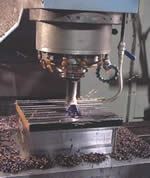
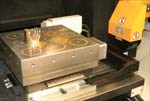
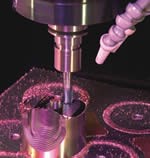

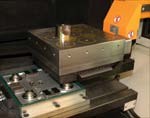










.jpg;maxWidth=300;quality=90)



